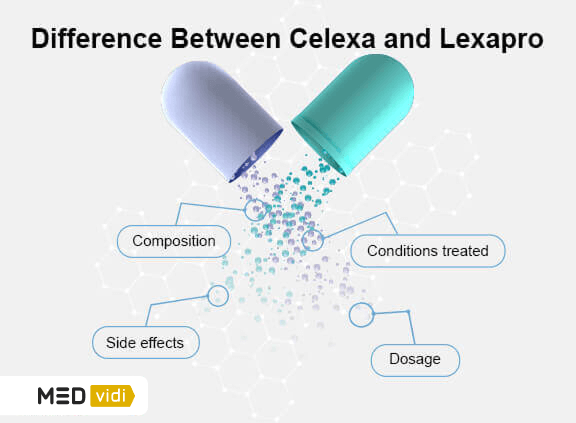Their inclusion does not guarantee they will be prescribed to any individual, as treatment decisions are ultimately at the discretion of healthcare providers. Healthcare providers may prescribe other medications or recommend non-pharmacological treatment based on the patient’s unique health circumstances and needs. Read more
Both
Highlights
- Celexa (citalopram) and Lexapro (escitalopram) are both antidepressants that belong to a class of selective serotonin reuptake inhibitors (SSRIs).
- The main difference between Celexa and Lexapro is in their chemical structure; the active ingredient of Lexapro is a more pure and potent form of Celexa’s.
- Both Celexa and Lexapro are registered for treating major depressive disorder (MDD).
- Only Lexapro is FDA-approved for generalized anxiety disorder (GAD).
With so many treatments out there for depression and anxiety, and an overload of information about them online, it can get overwhelming. This article will discuss and compare two commonly prescribed first-line options: citalopram (Celexa) and escitalopram (Lexapro).
What Are Celexa and Lexapro?
Celexa and Lexapro belong to the same group of antidepressant medications called selective serotonin reuptake inhibitors (SSRIs); you might be more familiar with their generic names, citalopram and escitalopram, respectively.
Citalopram is the older of the two; it was developed in the 1970s and was introduced in the US in 1998. Research on escitalopram began about twenty-five years later and was approved for use in the US in 2002.
While the FDA has approved both Celexa and Lexapro to manage major depressive disorder (MDD), only Lexapro is registered for the treatment of generalized anxiety disorder (GAD). They are also used off-label. It means that a doctor can prescribe medication when it’s not approved by the FDA for the treatment of these medical and mental health issues if they decide the benefits outweigh the potential risks.
Common uses | ||
Major depressive disorder (MDD) | ✅ FDA-approved | ✅ FDA-approved |
Generalized anxiety disorder (GAD) | Off-label | ✅ FDA-approved |
Off-label | Off-label | |
Off-label | Off-label | |
Off-label | Off-label | |
Premenstrual dysphoric disorder (PMDD) | Off-label | Off-label |
Posttraumatic stress disorder (PTSD) | Off-label | Off-label |
Both medications are available in an oral solution (liquid) and tablet form.

How Celexa and Lexapro Work
Because Celexa and Lexapro are
So, if this is the case, what is the difference between citalopram and escitalopram?

Building Block Difference Between Celexa and Lexapro
Celexa and Lexapro don’t have the same chemical formula.
Citalopram[4] is made up oftwo mirror-image forms of the same component[5] (like left and right hands), ‘R’ and ‘S.’ But only the ‘S’ form works for mental health conditions. Sometimes,‘R’ interferes with ‘S’[6] , making its action weaker in some people.- Escitalopram only contains the
active ‘S’ molecule[7] , hence the es (phonetic spelling of ‘S’) at the beginning of its name.
In simple terms, escitalopram is a more pure and potent form of citalopram. So, Lexapro is stronger than Celexa, meaning it achieves similar effects at lower doses.
What Does This Mean for Their Dosages?
Because escitalopram is more potent than citalopram, the dosage for Lexapro is about half that of Celexa. For adults with MDD or GAD, the starting dose for
However, in certain groups, such as older adults or individuals with elevated liver enzymes, the dosing ranges are halved: Lexapro is reduced to 5-10 mg per day, while the dose for Celexa is lowered to 10-20 mg per day.
Note that the dosage is chosen individually, and the above-mentioned typical dosages are provided for informational purposes only. Consult your physician to determine the most suitable course of treatment for you.
How Long Does It Take for Celexa and Lexapro to Work?
It varies from case to case; however, let’s look at the trend for Celexa and Lexapro when it comes to improvement of depressive symptoms.
Patients on citalopram[4] can start to feel a difference between 1 and 4 weeks, with an average of 2 to 3 weeks. However, the complete response may take 8 to 12 weeks.A study showed that escitalopram[10] , compared to most other antidepressants, including citalopram, works faster; this makes sense because of its more potent action.
Lexapro and Celexa Side Effects
Here again, overall, because escitalopram is purer, it has more specific targets; therefore, it has a lower risk of side effects because its targets are more specific. However, they both have the potential for life-threatening reactions.
Serious Shared Side Effects
Black Box Warning for Both
Young adults and children have an increased risk of suicidal thoughts and actions when taking Celexa or Lexapro.
Low Blood Sodium
Low blood sodium might present as a headache, poor concentration, or memory impairment, confusion, weakness, falls, seizures, and coma. It is caused by inappropriate antidiuretic hormone secretion.
Most Common Shared Side Effects
- Fatigue
- Nausea
- Increased sweating
- Sexual problems like ejaculatory delay, decreased libido, and erectile problems
- Decreased appetite
- Dry mouth
While Lexapro and Celexa share several common side effects, some are more likely to occur with one medication than with the other. For example, patients on Celexa are more likely to experience sleepiness, fast heartbeat, low blood pressure, and agitation. Whereas, patients using Lexapro are more likely to experience sleeping problems and heartburn issues. Note that there are also other potential side effects, so remember to discuss that with your healthcare provider.
Before we move on, we know there is one more topic you’d like to learn more about. You might have heard that antidepressants might cause weight gain, so is it true for Celexa and Lexapro? Let’s take a closer look.
Celexa vs. Lexapro: Weight Gain
Antidepressants have a bad reputation for increasing weight. It’s believed that the main reason for this is that when people feel better, their appetites return. A recent study
Another way of looking at it is that in the first year of using escitalopram, 10 to 15 out of 100 people will
In fact, in controlled trials before the medications went to market, patients on
So, although there might be a chance of weight gain on both medications, the risk, in most cases, is low, and the difference is small.

Celexa and Lexapro: Possible Drug Interactions
Any medication will have drug-to-drug interactions, and
- An absolute no-no is within two weeks of another type of antidepressant, monoamine oxidase inhibitors (MAOIs). This is because of the increased risk of serotonin syndrome, which happens when the SSRIs are prescribed together with other medications that increase serotonin. Too much serotonin can be life-threatening.
- Other medications that can cause serotonin syndrome when taken with Celexa or Lexapro include medicines for migraines, attention deficit hyperactivity disorder, and other mental health conditions; strong pain medication, and over-the-counter herbs and supplements, like St. John’s Wort.
- Another forbidden medication is pimozide, used to treat Tourette’s disorder, because of dangerous heart effects.
- People on aspirin, nonsteroidal anti-inflammatory drugs, and blood thinners can have a higher risk of bleeding when taking these medicines together with Celexa or Lexapro.
Additionally, citalopram should not be used with other medications that affect heart rhythm, such as other medications used to treat mental illness, antifungals, and some antibiotics.
Who Shouldn’t Take Celexa or Lexapro?
Never
Under no circumstances should people who are allergic to the generic component, who are currently taking pimozide, or monoamine oxidase inhibitors within 2 weeks use these medications.
With Caution
Celexa and Lexapro should be prescribed with caution in people with:
- Bipolar disorder (without concurrent use of a mood stabilizer)
- Other prescribed psychiatric medications
- Epilepsy
- Heart conditions (particularly Celexa)
- Increased eye pressure
- Existing sexual health issues
So, how do you choose between the two? Your doctor will take many factors into account before helping you decide which is more appropriate.
Is Celexa or Lexapro Better for Anxiety?
When assessing Celexa vs. Lexapro for anxiety, the first thing to consider is that Lexapro is FDA-approved to treat generalized anxiety disorder. This reflects that escitalopram has stronger scientific evidence for easing anxiety symptoms, which was confirmed in studies. However, individual responses may vary, so it’s important to follow your doctor’s instructions.
Is Celexa Better than Lexapro for Depression?
There is no one definite answer because the choice of medication and response to it are highly individualized. Lexapro may have a slightly faster onset of action in some patients, though both can take several weeks.
Summarizing What You’ve Learned So Far
Similarities Between Celexa and Lexapro
|
Medication |
Celexa |
Lexapro |
|
Class |
Selective serotonin reuptake inhibitors (SSRIs) |
|
|
Typical side effects |
|
|
|
Withdrawal symptoms |
Doctors will taper doses slowly when stopping the medication to avoid withdrawal symptoms:
|
|
|
Generic availability |
Widely available |
|
Differences: Celexa vs. Lexapro
Brand name | Celexa | Lexapro |
Active ingredient | Citalopram | Escitalopram |
FDA-approved uses |
|
|
Age groups |
|
|
Usual dosing | 20 mg to 40 mg | 10 mg to 20 mg |
Efficacy comparison | Full effect from 8 to 12 weeks | Some studies suggest that escitalopram works faster and better for symptoms of anxiety and depression compared to citalopram in MDD |
Can You Switch From Celexa to Lexapro or Vice Versa?
Doctors may consider changing their patients’ prescriptions if symptoms don’t improve as expected.
While this article may suggest that Lexapro is the better medication, based on the above-mentioned studies, some patients may not respond to it. In this case, doctors may consider switching from Lexapro to Celexa, or other antidepressants, to find an effective option.
The opposite is also true; your doctor might recommend that you switch from Celexa to Lexapro if your symptoms are not controlled, or you are more anxious than depressed.
You may wonder how long it takes to notice the difference when switching from Celexa to Lexapro, or vice versa. That depends on the individual and the severity of the baseline condition. However, it usually takes about two weeks to notice an improvement.
Escitalopram vs. Citalopram: Cost and Insurance Coverage
Celexa and Lexapro are the original brand names of the first citalopram and escitalopram medications on the market; these days, there are many generic forms available. Reports are that the
The cost per script for escitalopram versus citalopram remains between 2 and 5 times higher for insurance enrollees, even though doctors prescribe escitalopram more often.
Final Thoughts
Celexa and Lexapro are both FDA-approved treatment options for mental health conditions and are sometimes used off-label for a range of other conditions. When choosing the appropriate antidepressant for you, your healthcare professional will consider many things. Even then, people have different responses to medication, and you may need to have a change in treatment.
If you would like to find out more about diagnosing and managing depression or anxiety, or if you’re not feeling better on your current medication, book an online consultation with a MEDvidi provider today.
FAQs
Can you take Celexa and Lexapro together?
Is Celexa more calming than Lexapro?
Is Celexa or Lexapro better tolerated?
Is citalopram the same as escitalopram?
No, escitalopram is a purer form of citalopram. Citalopram is made up of two mirror-image building blocks, ‘R’ and ‘S,’ but only the ‘S’ form works for mental health conditions; escitalopram only contains the active ‘S’ molecule.













